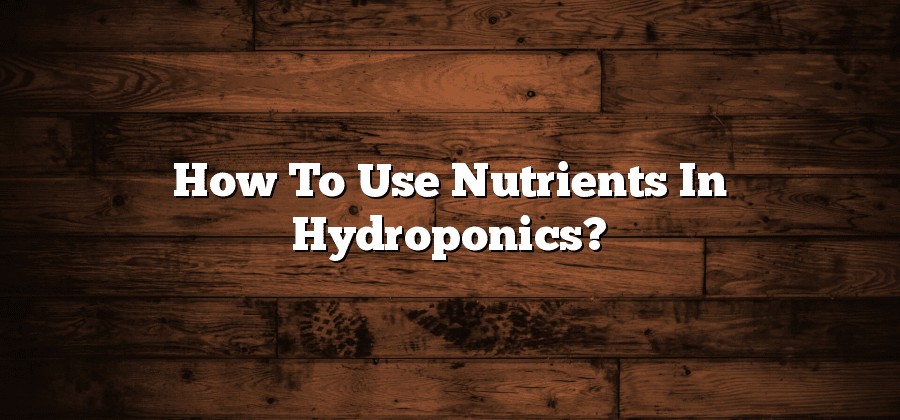Understanding the Role of Nutrients in Hydroponics
Hydroponics, a method of growing plants without soil, relies on the precise combination and balance of nutrients to support plant growth and development. Unlike traditional soil-based cultivation, where plants extract nutrients from the soil, hydroponics involves delivering nutrients directly to the plant’s root system through a water-based nutrient solution. This allows plants to take up nutrients more efficiently, leading to faster growth, increased yield, and better overall plant health.
In hydroponics, the role of nutrients is paramount. Just like humans, plants require a variety of essential nutrients to thrive. These include macronutrients such as nitrogen, phosphorus, and potassium, which are needed in large quantities to support plant growth and structural development. Additionally, plants also require micronutrients, such as iron, zinc, and manganese, which are needed in smaller quantities but are equally critical for various metabolic processes. By understanding the role of these nutrients and their specific functions within the plant, hydroponic growers can tailor their nutrient solutions to meet the specific needs of their crops, resulting in optimal growing conditions and improved plant performance.
Choosing the Right Nutrient Solution for Hydroponics
When it comes to hydroponics, choosing the right nutrient solution is a crucial step in ensuring the success of your system. Nutrients are essential elements that plants need to grow, and in traditional soil gardening, these nutrients are naturally present in the soil. However, in hydroponics, the plants are grown in a soilless medium, so it is necessary to provide them with the necessary nutrients directly.
There are numerous nutrient solutions available in the market, each tailored to meet the specific needs of different plants and growth stages. It is important to carefully select a nutrient solution that contains all the essential macronutrients and micronutrients required for optimal plant growth. Factors such as the type of plants you are growing, the growth stage of the plants, and the water quality in your area should all be considered when choosing the right nutrient solution for your hydroponic system. The right balance of nutrients will not only promote healthy plant growth but also help prevent nutrient deficiencies or toxicities that can hinder your plants’ progress.
Balancing Macronutrients in Hydroponic Systems
Balancing macronutrients is a crucial aspect of successful hydroponic systems. Macronutrients, including nitrogen (N), phosphorus (P), and potassium (K), play essential roles in plant growth and development. These nutrients are required in larger quantities compared to micronutrients, making them the primary components of nutrient solutions used in hydroponics.
Nitrogen is responsible for promoting leafy growth and efficient photosynthesis. It is an integral component of amino acids, proteins, and chlorophyll, all of which are vital for plant health and productivity. Phosphorus, on the other hand, aids in energy transfer and the development of healthy root systems. It is involved in many essential processes, such as DNA synthesis and cell division. Lastly, potassium is crucial for water regulation within plant cells, promoting overall plant vigor and disease resistance. Achieving the right balance of these macronutrients is crucial for optimizing plant growth and obtaining high yields in hydroponic systems.
Finding the right balance of macronutrients can be achieved through careful adjustment of nutrient solutions. It is essential to monitor the nutrient levels regularly and make necessary adjustments based on plant needs. Conducting regular water and nutrient analysis can help determine the nutrient absorption rates and ensure the plants receive an optimal nutrient supply. Moreover, different plant species have specific macronutrient requirements, so it is crucial to consider these differences when formulating nutrient solutions. By carefully balancing macronutrient levels, hydroponic growers can ensure that their plants receive the necessary nutrients for healthy growth and development.
Optimizing Micronutrient Levels in Hydroponics
Micronutrients are an essential component in optimizing the growth and development of plants in hydroponic systems. These essential elements, which include iron, manganese, zinc, copper, boron, and molybdenum, play crucial roles in various physiological processes, such as enzyme activation, photosynthesis, and nutrient uptake. However, achieving the optimal levels of micronutrients in hydroponics can be challenging, as they are required in small quantities, and imbalances can result in nutrient deficiencies or toxicities.
To optimize micronutrient levels in hydroponics, it is crucial to carefully monitor and adjust nutrient solutions. Conducting regular water and plant tissue analysis can provide valuable insights into the nutrient status of the system. This information can help growers identify any imbalances or deficiencies in micronutrients. Once the micronutrient levels are determined, appropriate adjustments can be made by either increasing or decreasing the dosage of the nutrient solution. It is important to note that the specific requirements of micronutrients may vary depending on the plant species being grown, its growth stage, and environmental conditions. Therefore, growers should familiarize themselves with the specific micronutrient requirements for each crop and make adjustments accordingly.
Monitoring and Adjusting pH in Hydroponic Nutrient Solutions
Maintaining the proper pH level in hydroponic nutrient solutions is crucial for ensuring optimal plant growth and nutrient uptake. pH refers to the acidity or alkalinity of a solution and is measured on a scale of 0 to 14, with 7 considered neutral. In hydroponics, most plants prefer slightly acidic conditions, with a pH range of 5.5 to 6.5.
To monitor the pH level in hydroponic nutrient solutions, it is essential to use a reliable pH meter or pH test strips. These tools allow growers to accurately measure the acidity or alkalinity of the nutrient solutions and make necessary adjustments. pH meters are more accurate but require regular calibration and maintenance, while pH test strips provide a quick and convenient way to obtain a rough estimate of the pH level. Regular monitoring of the pH level is crucial as it can fluctuate due to various factors such as nutrient absorption, evaporation, and the release of gases by plants.






